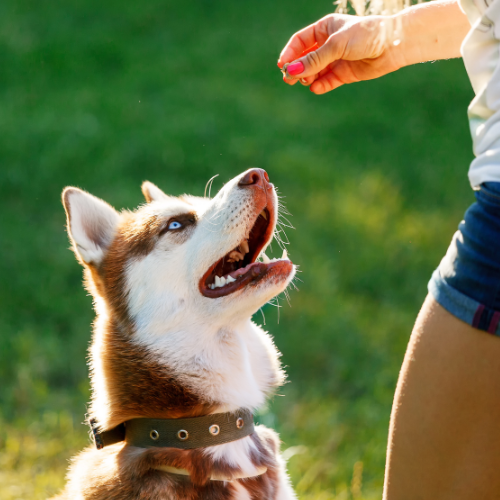The Benefits of Positive Reinforcement Training
Training your dog is an essential part of ensuring they grow into a well-behaved and happy companion. Among the various training methods available, positive reinforcement training stands out as one of the most effective and humane approaches. This method focuses on rewarding desired behaviors rather than punishing unwanted ones, creating a positive and enjoyable learning experience for both the dog and the owner. In this blog post, we will explore the concept of positive reinforcement and its numerous advantages over other training methods.
What is Positive Reinforcement?
Positive reinforcement involves rewarding a dog for displaying desired behaviors. The rewards can be anything the dog finds motivating, such as treats, praise, toys, or playtime. The fundamental idea is to encourage the repetition of good behavior by providing a positive outcome. For example, if a dog sits on command and receives a treat, they are more likely to sit again in the future, anticipating the reward.
Advantages of Positive Reinforcement Training
- Strengthens the Bond Between Dog and Owner: Positive reinforcement fosters a strong and trusting relationship between the dog and their owner. By using rewards and praise, the owner becomes a source of positivity and encouragement, which enhances the bond and makes training sessions enjoyable for both parties.
- Promotes Long-Term Behavioral Changes: Positive reinforcement focuses on encouraging desirable behaviors, making it more effective for instilling long-term behavioral changes. Dogs learn to associate good behavior with positive outcomes, leading to consistent and reliable behavior over time.
- Reduces Stress and Anxiety: Unlike punishment-based methods, positive reinforcement creates a stress-free learning environment. Dogs are not subjected to fear or intimidation, which can lead to anxiety and aggression. Instead, they are motivated to learn and perform well because they anticipate rewards and positive interactions.
- Encourages Active Learning: Positive reinforcement encourages dogs to actively participate in the learning process. They become eager to learn and engage with their owners, leading to quicker and more effective training sessions. Dogs trained with positive reinforcement are often more enthusiastic and willing to try new commands and tricks.
- Versatility and Flexibility: Positive reinforcement can be applied to a wide range of behaviors and training scenarios. Whether you’re teaching basic commands, advanced tricks, or addressing behavioral issues, this method is adaptable and effective. It can be used with dogs of all ages, breeds, and temperaments.
- Builds Confidence: Dogs trained with positive reinforcement develop confidence as they successfully learn and perform new behaviors. Each successful command and reward boosts their self-esteem and encourages them to take on new challenges. Confident dogs are more likely to be well-adjusted and less prone to behavioral problems.
- Enhances Socialization: Positive reinforcement can also aid in socializing your dog. By rewarding calm and friendly behavior around other dogs and people, you can help your dog develop positive associations with social interactions. This can lead to better behavior in public settings and improved social skills.
Positive Reinforcement vs. Other Training Methods
- Punishment-Based Training: Punishment-based training relies on correcting unwanted behaviors through negative consequences, such as scolding, leash corrections, or physical punishment. While this method can sometimes produce quick results, it often leads to fear, anxiety, and aggression. Dogs may learn to avoid the punishment rather than understanding the desired behavior. This approach can damage the bond between dog and owner and create a fearful and untrusting pet.
- Balanced Training: Balanced training combines elements of positive reinforcement and punishment. While it aims to use the best of both methods, it can still lead to confusion and stress for the dog. The inconsistent use of rewards and punishments can make it harder for dogs to understand what is expected of them.
Conclusion
Positive reinforcement training offers a humane, effective, and enjoyable way to train your dog. By focusing on rewarding good behavior and creating a positive learning environment, you can foster a strong bond with your dog, promote long-term behavioral changes, and build a confident and well-adjusted pet. Whether you are teaching basic commands, addressing behavioral issues, or enhancing social skills, positive reinforcement is a versatile and reliable training method that benefits both dogs and their owners. Embrace this approach, and you’ll see the positive impact it has on your dog’s behavior and overall well-being.

